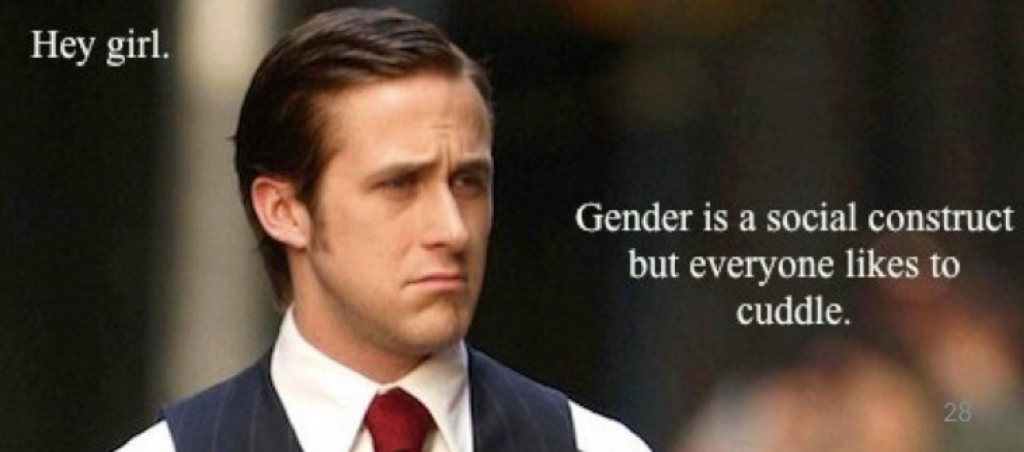It’s 2025 and hardly anyone keeps the (online) world in such suspense then the so called “performative male” : little internet phenomena have spilled over into the real world to such an extent and triggered such a chain reaction of “meta-memes” then this “new” archetype of men. Nowadays, it is not just a particular example of performative masculinity in the wild that causes a stir when posted on the internet, but also numerous memes commenting on this trend – and those in turn criticizing and parodying this first generation of commentators, and so on and so forth – which have become a cult phenomena.
Performative Male Starter Kit
According to Wikipedia, a “performative man” is someone who performs both feminism and emotional sensitivity. In practice, this can mean for example, having tucked a book by Bell Hooks under your arm, and listening to romantic music (the name of the artist Clairo often comes up in relevant guidebooks), while having “profound” conversations over a cup of oat milk cappuccino.
There are countless “instructions” circulating on the internet on how to become a “performative male” (hereinafter referred to as “PM”), most of them highly satirical.
There seems to be a whole range of modern iconography that refers to this archetype of man, and it seems that only the combination of symbolic accessories makes a person a real PM. Drinking matcha is generally tolerated, but in combination with a tote bag and a nose ring, it is already a dangerous matter.
The recurring main criticism: the performance is – well, not real. People are mocked, parodied, and shared thousands of times under the assumption that the image portrayed – that of the soft, liberal, intellectual, emotionally mature man – is not what lies behind the façade. As is so often the case (online), it’s the lack of authenticity that is criticised.
On what stage?
The phenomenon of “performative males” can be found both in the real world and on the internet. In the cityscape, they seem to appear particularly frequently in bookstores, cafes, on park benches, and sometimes in galleries. There are however also many ways to perform online: from self-love quotes in your Instagram bio to reposts of feminist accounts, the possibilities seem endless. Nowadays, there are even improvised, satirical ‘competitions’ taking place offline and worldwide to select who performs best the “performative male.” But how to perform a role that in itself already is a role?
Which audience?
Here we get to the real question: why all this?
Most articles that address the topic point out that the PM is primarily after one thing: the (romantic) attention of women. It sounds almost too simple to be true: it seems like only in 2025, showing interest in female issues has become a strategy for winning women’s favour – be it genuine interest or not.
In the animal kingdom, the trend of male performance is nothing new: males of many species put on a great show to impress and ultimately mate a female, for example the greater lophoronia. Besides phenotypical attributes like the blue collar, the male birds will perform a literal dance to attract the females.
Back to the human realm, the development of the “performative male” however, is emerging at a time, when there is also often talk, especially online, of the so-called “lonely male epidemic,” describing the alleged difficulties of (heterosexual) men in the recent years to find a partner and eventually also profound social connection in general. Does that mean the “performative male” was born out of sheer desperation?
And how does that relate to the enormous avalanche of satire this phenomenon has created?
The world is your stage
I believe something people often overlook here is the fact that performing identity and therefore gender, is absolutely nothing new and also not something unusual among humans.
One might even take it so far to say, gender is always and by everyone performed. Sounds familiar? That’s because this thought was already coined by Judith Butler, influential feminist philosopher and gender studies scholar, in the 1990s, brought forward in her book Gender Trouble: Feminism and the Subversion of Identity.
“… gender is not a fact, the various acts of gender create the
idea of gender, and without those acts, there would be no
gender at all. Gender is, thus, a construction that regularly
conceals its genesis.” 1
According to Butler, gender therefore is not something you are, but rather something you do, or in other words: perform.
What is now interesting about the PM, is that he takes the performance so far that it seems to create a major irritation among people and that is, I believe, due to two different factors.
First, this particular performance of masculinity, as opposed to earlier archetypes (think physically strong, family oriented, provider type of man) is taking on attributes that originally, or better, stereotypically, are associated with the female spectrum of performing gender. This taps into a general happening around gender that is people constantly disciplining others for doing their gender “wrongly”, for example by remarks or looks in gendered bathrooms. Butler would argue that this deep down proves that people know gender is always performed – otherwise there wouldn’t be a way to do it wrongfully.
Secondly, especially in the context of dating, the 2025 “performative male” seems to attract women under false promises, leading to an overall “fear” of (literally) falling for a man, who in the end turns out to be not that feminist, politically motivated or soft spoken at all. In certain cases, this weaponising of vulnerability goes so far to be in favour of what is called the “manosphere”, an anti-female movement, starting with mild sexism to blunt hatred. Being more a subject of debate and parody from the beginning, I don’t believe the PM generally holds that a much power or danger. The fascination around them however illustrates what certainly is a symptom of our age and digital culture: the constant loop of individualism in self-representation and a major tendency towards conformity, belonging and recognition at the same time.
Wether one is performing a certain masculinity or criticising one of the other – and the spectrum here goes from “alpha finance male” to what we now call the “performative male” (keyword Labubu and Sally Rooney) – it is always about forming one’s own identity by clearly distinguishing it from others, thus it being a derivative from an already existing identity.
Sources
- Butler, Judith. “Performative Acts and Gender Constitution: An Essay in Phenomenology and Feminist Theory.” Theatre Journal 40, no. 4 (1988): 519–31. https://doi.org/10.2307/3207893. ↩︎







Hi, I loved your post a lot. The performative male meme and figure is already so funny. I just loved the academic input you brought to the question because Judith Butler’s work is such an interesting and relevant author to include and base your reflections on. It really made me reflect on the previous thoughts I had had on the subject.
The visuals are also on point.
How interesting to read all this! I didn’t know that this type of man had actually been given a name: “performative man.” I think they always look a little extra. They really want to feel seen and exude a bit of femininity. Personally, I think everyone should be able to wear and do whatever they want. But it is noticeable that a lot of men are following this trend and therefore almost all look the same. I think this has been the case with women for much longer; they just want to look like the models in fashion magazines. I just think it’s a shame that they no longer decide for themselves what they think looks good or attractive. They just look at the trend and buy everything they are told to buy.
Conclusion: I think the idea behind being more yourself and therefore allowing men to show more emotions is really good, I support that one hundred percent. But I find it strange that you do that by simply copying and following. You want to express yourself more, but then you only express the role model you follow and you don’t figure out for yourself how you want to express yourself.
I wonder what this trend tells us about why people are drawn to these performances. Is it purely a strategy for social recognition, or does it reveal anxieties about how we form relationships and connect with others? In a sense why certain people have the willingness to be “performative” than others. I think this is a really interesting phenomenon: online stereotypes are starting to influence how we perform ourselves offline. For example, being a “performative male” can also include drinking oat-milk lattes or reading certain books. It seems that our identities are now shaped through both online representations and offline practices, and the two are no longer separable – precisely in the way Judith Butler describes.
Very Interesting! As a guy I definitely came across this trend on social media. The question is whether these “performative” males feel authentic in their actions. I mean I prefer these types of guys to the ultra masculine provider types, but like authenticity still matters. I’d rather chill with someone’s true self that I disagree with then a fake self that I agree with.